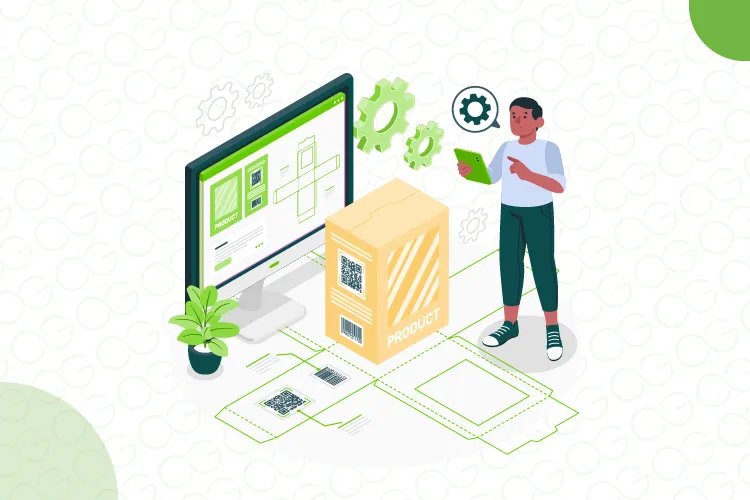Unified Product Information Management (PIM) for Omnichannel Retail

Imagine entering a physical store, finding a product you love, and later browsing the retailer's online platform to learn more about it—only to discover conflicting information. The product dimensions are different, the color options don't match, and the pricing feels inconsistent. How likely are you to follow through with your purchase? This disconnect between channels is precisely why unified product information management (PIM) has become a cornerstone in modern retail.
Today customers don’t just shop in stores or online—they navigate between websites, social media, mobile apps, and even voice-activated assistants. A Unified PIM system ensures that wherever the customers interact with the brand, they encounter reliable, up-to-date, and compelling product information.
At its core, product information answers a simple yet critical question: “What am I buying?” When this information is inconsistent, incomplete, or incorrect, it erodes trust, frustrates customers, and disrupts the buying journey. The stakes couldn’t be clearer:
- A staggering 87% of shoppers consider detailed and accurate product descriptions crucial for making purchase decisions.
- Almost 74% of consumers are more likely to remain loyal to brands that deliver a seamless, consistent experience across all platforms.
Unified PIM acts as a single source of truth, ensuring that every channel communicates the same message. It helps customers make informed decisions, fostering trust and loyalty. A Unified PIM system is not just a tool; it’s an enabler of modern retail success. Let's take a closer look at the PIM system and explore how it can revolutionize the way businesses operate.

Unified PIM: Building trust through seamless, consistent product experiences
What is Unified Product Information Management (PIM)?
PIM centralizes the product information, manages it, and then publishes or distributes it via different channels and platforms. Unlike the traditional form of product information management software, a Unified PIM system incorporates all the disciplines within one coherent mechanism. This helps businesses organize their workflows smoothly, eradicate the possibility of errors, and establish consistency throughout their omnichannel operations.
Key Features of a Unified PIM
Some critical features that distinguish a Unified PIM from traditional systems:
- Centralized Data Repository: All product information, descriptions, images, prices, and specifications are stored in one single location.
- Multi-Channel Distribution Capabilities: Uniform PIM software allows easy distribution or syndication of product information across various sales channels consistently while maintaining uniformity.
- Integration with Key Business Systems: Seamless integration with ERP systems, e-commerce platforms, and supply chain management tools allows businesses to synchronize operations, reducing redundancy.
Importance of Unification
Why does unification matter in PIM? Let’s consider two hypothetical scenarios:
- Without Unification: A retailer updates the price of a product on their website but forgets to change that price on an online marketplace, which causes confusion and dissatisfaction among customers.
- With Unified PIM: After adapting PIM, any update is reflected throughout the platforms to ensure the dissemination of accurate and timely information for customers.
The Omnichannel Retail Landscape: Challenges Without a Unified PIM
Retail has become increasingly complicated as consumers have a variety of ways of interacting with their favorite brands. While this provides an unparalleled opportunity to know one's customers, such omnichannel approaches tend to carry with them lots of challenges—especially while managing the product information in a non-unified PIM environment.
Without a unified PIM software for omnichannel retail, retailers often grapple with the following problems:
- Inconsistent Product Data Across Platforms: Inconsistent product description, price, and availability across various platforms confuse customers and erode trust in a brand.
- Time-Consuming Manual Updates: Updating product information for each channel manually is inefficient and error-prone.
- Reduced Trust Due to Outdated or Incorrect Information: Customers expect accurate and valid data on a given product. An error and/or delay in updating results in negative feedback, resulting in the return of products, or even lost customers.
A compelling study by the Baymard Institute found that nearly 70.19% of online shopping cart abandonments are due to incomplete or unclear product information. Imagine the revenue lost due to such avoidable issues!

Benefits of Unified PIM in Omnichannel Retail
Unified PIM isn't just a back-office tool but rather the backbone of a successful omnichannel retail strategy. By creating an easier way of product information management and product content distribution it turns challenges into opportunities for any business. Here’s how:
- Enhanced Customer Experience: Unified PIM for omnichannel marketing ensures consistency by delivering uniform product data across physical stores, e-commerce platforms, and social media channels. This coherence fosters trust, making customers more likely to purchase and recommend the brand.
- Faster Time-to-Market: It gets rid of the bottlenecks created by fragmented systems through real-time updates and streamlined workflows. This means products reach customers faster to keep the brand ahead of the competition.
- Simplified Data Management: The system acts as a single source of truth about all product data. Teams can gain access to and update the centralized information without the manual juggling of several spreadsheets and multiple databases.
- Increased Revenue: Accurate, enriched product information means better search engine visibility and improved customer decision-making. When customers find what they need more quickly, they are most likely to convert.
- Scalability for Future Growth: The nature of the Unified PIM is non-static; it scales with increased volumes and the unique requirements of diverse sales channels.
Key Components of a Robust Unified PIM System
Building an effective Unified PIM system requires a strategic approach and key components that ensure its robustness.
Let's break down the key components that would make a PIM system drive omnichannel success.
- Data Centralization: A Unified PIM puts all the product attributes, images, metadata, and other vital information into one single repository. This single version of truth eliminates inconsistencies and, therefore, forms a basis for smooth data distribution.
- Channel-Specific Adaptability: Different channels have unique requirements for product data. Unified PIM enables tailoring data formats to meet the specific needs of different channels.
- Automation: The integrated PIM systems utilize AI and machine learning to automate processes like data enrichment, classification, and the detection of errors. This reduces human effort and increases time-to-market.
- Integration with Business Systems: A strong PIM software is integrated within ERP, CRM, and inventory management systems for an integrated flow of data that negates any form of silo.
- Analytics and Insights: Beyond managing data, a strong PIM extracts actionable insights regarding the performance of the products. Analytics help an organization to understand trends, identify gaps, and refine its strategies.

Stay ahead in omnichannel retail with data centralization, automation, and analytics.
Unified PIM in Action: Real-World Use Cases
Unified PIM systems are transforming the way businesses handle product information. Here are three compelling examples of how organizations have harnessed Unified PIM systems to achieve operational excellence.
Multi-Brand Retailer
Imagine a retailer managing multiple brands, each with hundreds of products, across diverse platforms like Amazon, Shopify, and physical stores. Product launches become a logistical nightmare due to fragmented data sources. With a Unified PIM system:
- Streamlined Processes: All product information is centralized and enriched, eliminating silos and ensuring consistency across channels.
- Rapid Launches: Instead of weeks, the time to launch new products is reduced to days, with automated workflows pushing updates to all platforms simultaneously.
- Enhanced Customer Experience: Accurate, engaging product descriptions and specifications reduce returns and improve customer satisfaction.
Niche Retailer with Seasonal Products
Consider a boutique retailer specializing in holiday-themed decorations. Seasonal peaks mean product relevance is time-sensitive. Before adopting a PIM system, this retailer struggled with inconsistent data and missed sales opportunities. Unified PIM brought transformative changes:
- Dynamic Campaigns: Accurate and timely updates to product listings, ensuring customers find the right products during peak seasons.
- Improved Visibility: Data-rich listings optimized for search engines boost visibility, driving higher traffic and sales.
- Flexibility: Quick adaptation to trends, enabling the retailer to adjust inventory and marketing strategies on the fly.
Social Commerce
A growing trend in e-commerce is selling directly through social platforms like Instagram and Facebook. Businesses leveraging social commerce often face challenges in managing visually engaging, accurate product listings. Unified PIM offers a solution:
- Optimized Listings: Automatically curated data ensures product titles, descriptions, and images are perfectly tailored to platform requirements.
- Increased Engagement: High-quality visuals and precise information attract more clicks and conversions.
- Efficient Updates: Changes in pricing or inventory are instantly reflected across all channels.

Transforming retail and powering retail success with Unified PIM systems
Steps to Implement a Unified PIM System
Transitioning to a Unified PIM system requires careful planning and execution. Here’s a step-by-step guide to ensure a smooth and successful implementation:
- Assess Current Product Data Management Practices: Start by evaluating the existing processes. Look for silos, redundant tasks, and data inconsistencies. Are product attributes consistent across all platforms? Do different teams have access to outdated or incomplete data?
- Choose the Right PIM Solution: The market offers a variety of PIM solutions. Select one that aligns with the businesses’ needs and goals. Look for scalability to handle growing catalogs, integration with existing systems, user-friendliness, and cost-effectiveness.
- Plan for Data Migration and Integration: Migrating data from legacy systems is a critical phase. Clean and standardize data before migration, use automated tools for efficient transfer and conduct thorough post-migration testing.
- Train Your Team: Even the most advanced system will underperform if users aren’t trained to utilize its full potential. Retailers should focus on basic navigation and data entry protocols and utilize advanced features like automation and reporting tools.
- Continuously Monitor and Optimize: Implementation isn’t the end—it’s the beginning of ongoing optimization. Periodically check for inaccuracies and gaps in data and ensure the PIM software adapts. Track metrics like time-to-market and error rates to measure success.
Ginesys One: Your Partner for Unified Item Information Solutions
Ginesys One provides an advanced ecosystem designed to tackle the challenges of omnichannel retailing with unmatched precision and efficiency. At the center of its ecosystem is Ginesys ERP, which serves as a centralized and unified source of truth for all item information. Key Capabilities Include:
- Centralized Item Data: Ginesys ERP consolidates all item details, including descriptions, prices, and tax rates.
- Real-time Sync Across Channels: The ERP to OMS and POS integration, automates synchronization across physical and digital storefronts.
- Taxation Compliance: Unified tax data simplifies GST return filing and supports accurate e-invoicing. The correct item tax rates are picked for GST e-invoicing and return filing.
Features Tailored to Omnichannel Retail Needs
What sets Ginesys One apart is its ability to cater to the nuanced demands of omnichannel retailing. Ginesys One delivers with:
- Dynamic Inventory Updates: Stock levels are updated in real-time, allowing for smarter inventory allocation and reduced overselling.
- Unified Pricing: Consistent product pricing across channels enhances customer trust and satisfaction.
- Seamless Returns Management: Integrated systems enable customers to buy online and return in-store, or vice versa, with no disruptions.
- Flexible Tax Handling: A robust tax engine ensures accurate application of item-specific tax rules for GST compliance.

Case Study: Achieving Omnichannel Excellence with Ginesys One
Shree, a women's ethnic wear brand, sought to expand its retail presence and enhance operational efficiency. Facing challenges with limited business reporting and a lack of innovation in their existing ERP system, they turned to Ginesys One for a comprehensive solution.
Challenges:
- Inadequate business reporting capabilities.
- Lack of integration between POS and ERP systems.
- Need for a scalable solution to support rapid growth.
Solutions Implemented:
- Integrated ERP and POS: Ginesys provided a merged ERP and POS system, streamlining operations and ensuring real-time data synchronization across all stores.
- Business Intelligence (BI): Enhanced reporting tools offered detailed insights, enabling informed decision-making.
- Omnichannel Integration: With the integration of Browntape OMS, Shree achieved true omnichannel capabilities, managing both online and offline sales channels effectively.
Results:
- Expanded from 30 to over 100 exclusive brand outlets (EBOs) and 3,000+ retail points.
- Improved inventory management and operational efficiency.
- Enhanced customer experience through seamless integration across channels.
Mr. Amit Arora, CTO of Shree, remarked, "Ginesys keeps itself updated with new technologies and solutions; because of this, we can see them as our technology partner for the next 5 years."

Unify retail: Ginesys One simplifies item data synchronization across channels
Why Choose Ginesys?
When selecting a technology partner for omnichannel success, expertise and innovation matter. Ginesys stands out for several reasons:
- Retail Technology Expertise: With decades of experience, Ginesys has an unmatched understanding of the complexities in retail. From large-scale enterprises to mid-sized businesses, it tailors its solutions to meet specific operational needs.
- Comprehensive Suite of Tools: The ecosystem doesn’t stop at item information management. It includes ERP, POS, OMS, and analytics, offering an end-to-end solution for omnichannel success.
- Continuous Innovation and Support: The regular updates ensure the systems stay ahead of industry trends, while dedicated support teams help with troubleshooting and optimizing operations.
Future Trends in PIM and Omnichannel Retail
Emerging technologies and global market shifts redefine how businesses manage and present product data. Let’s explore some of the key trends shaping the future of PIM in the context of omnichannel retail:
- AI and Machine Learning: AI and machine learning algorithms help automate product categorization and attribute generation. These technologies analyze product images, descriptions, and related data to assign categories and attributes with remarkable precision.
- Personalized Product Information: By integrating personalization capabilities into PIM systems, businesses can dynamically adjust product information based on individual customer preferences and browsing history.
- Globalization and Localization: Unified PIM systems are now adept at managing multilingual product data, localized content, and region-specific compliance requirements. This ensures a consistent brand image while meeting the unique demands of diverse markets.
- Integration with Emerging Channels: The rise of AR, VR, and metaverse platforms is transforming product interactions, with Unified PIM adapting to deliver enriched data such as 3D models, textures, and interactive features.

Unify retail success: Centralized item management with Ginesys One
Final Thoughts
Today, a Unified PIM system is not just a tool; it’s a strategic enabler of seamless omnichannel experiences. From automating tedious tasks with AI to preparing for the future of AR/VR commerce, PIM systems are at the center of retail transformation.
Are you ready to future-proof your product information management strategy? Ginesys One offers robust, innovative solutions to help your business thrive in a competitive retail landscape. Explore how Ginesys can transform your PIM approach to deliver exceptional customer experiences.
